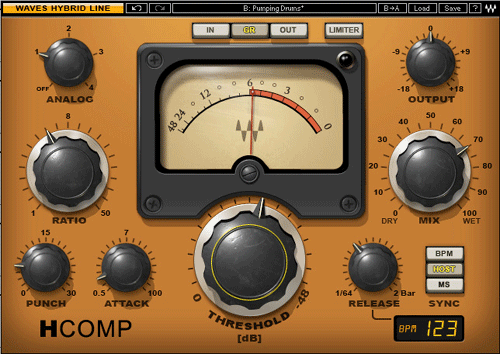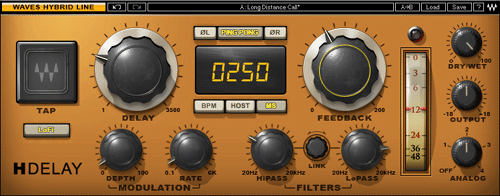by Barry Rudolph
|
WAVES Hybrid Plug-Ins
by Barry Rudolph |
|
 There is something warm and fuzzy about WAVES' new Hybrid line of plug-ins. They have the look, feel and sound of outboard gear I grew up with 'way too back in the day' but they operate in a modern way with the power and precision that only a plug-in processor can provide.
There is something warm and fuzzy about WAVES' new Hybrid line of plug-ins. They have the look, feel and sound of outboard gear I grew up with 'way too back in the day' but they operate in a modern way with the power and precision that only a plug-in processor can provide.
The WAVES Hybrid Line is a win-win winner--get all the great sounds of those old processors when they are working correctly on a perfect day without all the downside issues that invariably came up--some that even spoiled an otherwise great mix.
Forget about the elaborate setup times required, reliability problems, inherent technical limitations and noisy operation--those are gone. Those old bugaboos are replaced by precise control, reliable and repeatable performance, real dynamic range, and new modes I only dreamt of back then.
Enter Hybrid
 The new WAVES Hybrid line starts with two plug-ins: H-Comp, a dynamics processor that combines the modeled behavior of transformers, tubes, and transistors; and H-Delay, a time delay processor that provides tape recorder-based effects like flanging, phasing, slap-back echo, ping-pong delay, plus chorus and double-tracking effects from newer analog, "bucket brigade" or charge-coupled device-based units.
The new WAVES Hybrid line starts with two plug-ins: H-Comp, a dynamics processor that combines the modeled behavior of transformers, tubes, and transistors; and H-Delay, a time delay processor that provides tape recorder-based effects like flanging, phasing, slap-back echo, ping-pong delay, plus chorus and double-tracking effects from newer analog, "bucket brigade" or charge-coupled device-based units.
Hybrid is available in Native (RTAS, AU, VST) and in TDM for both MAC and PC platforms. The processors are carefully modeled in both stereo and mono versions (H-Delay also has a mono-to-stereo mode) and operate up to 192kHz session sample rates in Native and up to 96kHz in TDM. iLok dongle authorization is required.
As with all WAVES plug-ins, the included WaveSystem toolbar manages all user and factory presets with 32 levels of undo/redo, preset A/Bing, and recall/save/load functions.
Hybrid H-Comp-- Old Dog But New Tricks
Like H-Delay, H-Comp's GUI is rugged and old-fashion-looking with big black bakelite knobs, a large VU meter and LED time delay digital display, and rectangular lighted punch buttons. The gain reduction meter's needle rests "fully pinned" on the right side when in GR mode so you'll have the entire range of the meter to measure compression. I liked the large ratio knob too--it makes it easy to tweak but, of course, any of the knobs instantly set just by double-clicking and typing in a value.
H-Comp has a Mix control that mixes in some of the input signal (or Dry) with the compressed output. AKA parallel compression is possible with any DAW but requires extra routing and duplicating--it was a lot of trouble to patch and make it work well with an old tube compressor and a '70's-era console too. With H-Comp, it is built-in and ready to go and I liked that there is no phase/polarity issue to think about but I took exception to the way the gain reduction meter works.
As you mix more and more Dry signal into the output, the GR meter indicates less and less gain reduction. Waves intends the meter to show you total gain reduction of the audio but I'd still like to know how much the compressor is working because it may not be noticeable with an appreciable amount of dry signal mixed in.
Another old-school "pie in the sky" wish is granted with the Punch control. This control mixes the input signal's transient information into the output for more apparent loudness or punch. The effect is not subtle and I liked it on most sources--I used it a lot on bass guitars and bright rhythm guitar tracks because it kept the front or attack of the notes yet did not cause the output to increase very much.
BPM-based release time programmability was unheard of 'back in the day.' For limiter special effects on percussion overdubs, I used to manually "ride" or "play" the release control on an UA 1176LN Peak Limiter during the recording. Fairchild 670s, LA-2As, RCA BA-6As et al do not have variable release time knobs. In addition to seconds or milliseconds, H-Comp lets you set release times predicated on the session's tempo or any subdivision.
For example: severely compress a snare drum and set the release to the elapse time between quarter notes so that the compressor returns from gain reduction in time for another snare hit on the next backbeat. All good in theory until the drummer plays a drag or an eighth note fill between backbeats!
H-Comp Goes To Work
On bass guitar I compared the TDM version of H-Comp with the URS 1970-C compressor. With the same settings on both plug-ins and with both Punch and Analog controls set to zero on H-Comp, H-Comp had a nice clarity although I was happier with the vintage "dustiness" of Bobby Nathan's URS compressor. But all I had to do was add in some of H-Comp's Analog control and a sound reminiscent of analog tape modulation noise or harmonic distortion from super hot tape recording levels got mixed in--it's most noticeable at the maximum setting at 4.
Another apples to oranges comparison was between H-Comp (in RTAS mode) with SSL's Duende X-Comp plug-in on a female lead vocal. Again with Analog off and no Punch introduced and with all settings matched in value, I found H-Comp to sound fatter and a little louder. It's like comparing a modern compressor to an old tube stalwart--no clear winner--each has its place and value.
H-Comp has automatic gain makeup output level that I had to lower about 1.5 dB to match the vocal mix level. I like the automatic gain makeup but I wish there was a way to defeat it especially for making A/Bs.
Another good use for H-Comp was on snare drum tracks. The Wet/Dry Mix control, working like a parallel compression setup, mixes the sound of a heavily squashed snare drum (set to fastest attack time to get more sustain and ring and less attack) with the dry signal's original sound with the attack portion of the sound. I set the Wet/Dry to about 60% Wet.
H-Delay
 H-Delay is my main delay plug nowadays because it has all the features I require without adding other plug-ins as I usually do. First of all, there is up to 3500 MS of delay time without calling up other delays and it has infinite feedback. It also has a feature I call "gained up" feedback where, instead of getting softer and softer, the repeats getting louder and louder. Lots of creative possibilities there!
H-Delay is my main delay plug nowadays because it has all the features I require without adding other plug-ins as I usually do. First of all, there is up to 3500 MS of delay time without calling up other delays and it has infinite feedback. It also has a feature I call "gained up" feedback where, instead of getting softer and softer, the repeats getting louder and louder. Lots of creative possibilities there!
I like when you change the delay time whilst audio is playing through H-Delay. The capture audio changes in pitch--just like adjusting the playback head distance on a Maestro Echoplex or when changing the vari-speed setting on a reel-to-reel tape delay machines during delay echoes. This control, like all the controls on the Hybrid plugs, is automatable!
Other great modern features include: Tap tempo grabs the delay timing from just clicking on the Tap plateau; the LFO section modulates the delay time for making smooth chorus sounds and automatic flanger sweeps; and the delay time will follow session tempo or any musical subdivisions including triplets (delay time T suffix) and dotted notes (D).
The echo repeats from tape machine delay always deteriorated with each subsequent repeat--they dissolved into the existing noise floor. With H-Delay you have a choice anywhere between super clean and clear digital echo repeats and the sound of yesteryear using the restricted frequency response LoFi mode and/or the high pass and low pass filters. Both filters have identical 20Hz to 20kHz ranges and you can link them to produce a bandpass filter.
Like H-Comp, the Analog mode adds the sound we associate with analog signal paths and I found it to take some of the stiff and rough edges off the sound of typical digital delay lines.
Between the Analog mode, LoFi and the LFO modulation you've got covered all the sonic vagaries of a good old tape recorder or a hardware analog unit like a Yamaha AD-10 Analog Delay pedal.
H-Delay In the Studio
I set up two H-Delay plug-ins, panned left and right, on a stereo send in my latest mix. Unfortunately H-Delay does not have two separate delay outputs each with its own delay time setting.
For straight ahead time delays, I usually find the "dead on", session delay time and then set it a few MS late just to lay back the repeats. This also makes the echoes more hearable with less level than if they are hitting exactly with other percussive elements of the mix.
For vocal delays, H-Delay sounds great with the way the repeats decay in level. If you want a particular delay "throw" to last longer just automate the repeat knob to what you need for that moment. The infinite repeat feature worked well as a recurring "hook" in this remix I was doing--there was no need to sample and fly in vocal repeats as usually is done.
I also liked H-Delay for shorter delays associated with doubling and flanger effects. The LFO modulator comes in handy for changing delays over a short range of 1 to 3MS. Using LoFi and the filters produces a chorus and flanger sound like the old analog Marshall Time Modulator unit or, turn them off and get a sound reminiscent of the newer digital TC Electronic 2290 mono delay units.
Nostalgic but modern, the Waves Hybrid Line is a solid beginning to what I hope will become a whole collection of plug-ins based on old and newer effect processors. WAVES Hybrid is available in both TDM and Native and for much information, check out: www.waves.com/.
|
|
|
|
|